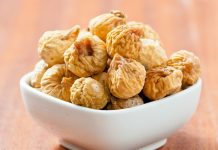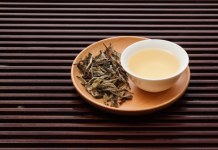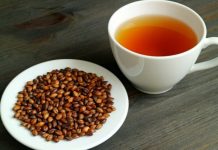The berry, Persimmon, is rich and sweet to taste but take care that you don’t give it to your newborn to eat. Infants about a year old are ready to eat this extremely health-giving fruit that can protect a child’s vision from eye loss, regulate his blood sugar levels, keep his digestive system ticking well and boost his immunity. Can you ask for anything more from one innocent fruit?
Persimmons are a powerhouse of health for children as they promote weight loss in obese or overweight children, their eyes from vision loss and retinal damage, improves their digestive system, fights cancer, increases immunity, stimulates heart health and increases energy for physical and mental activity, among others.
Persimmon

It is grown in eastern USA where it is known as a “dry fruit.” In certain parts of south-east Asia, it is used to make tea.
Can I give my baby Persimmons?
Eight to 10 months old infants can start having Persimmons in their diet. They are safe to eat, besides being easy to cook and tasty. They are also non-allergenic. Despite this, it’s best to consult your pediatrician before starting off your baby on this food.
Varieties of Persimmons
The two commonly found persimmon types in North America are Fuyu Persimmons and Hachiyas Persimmons. Both come from a genus better known as “fruit of the gods” in Greek, and they are ripe to eat in the winter.
- Fuyu Persimmons : They have flat bottoms and are squat in shape. They are orange in color, soft when ripe and are eaten raw, sliced and peeled in salads.
- Hachiya Persimmons : This variety of persimmons are long and oval shaped. They are tart and very soft and can be pulpy inside the fruit. They are best used for baking and they add a lot of humidity to cakes and puddings.
How to cook and serve your baby Persimmons?
When pureed and baked or added to other dishes, the Hachiya Persimmon can be very tasty. Its skin is very thin, so it needn’t be peeled. Once it is washed well, it can be steamed and pureed.
The Fuyu variety of Persimmons can be eaten like a fruit without peeling or cooking. It can also be steamed and then pureed.
Health Benefits of Persimmons
Persimmons are a great asset to children who take them on a regular basis. They can help in children’s growth and development in these ways:
Gets rid of a thick waistline: Being rich in fiber, children who digest food slowly will feel full for longer. Pectin, contained in fiber also helps control appetite by regulating blood sugar levels. Lastly, persimmons have stomach-soothing capabilities, so anyone eating this fruit won’t feel bloated.
Protects the vision from eye loss: Persimmon contains two ingredients, Lutein and Zeaxanthin, that help keep the vision in perfect condition and prevent retina damage. Persimmon also contains Vitamins A, C and K, which are highly antioxidant in nature and that are critical to eye protection, particularly from retinal damage.
Improves the digestive system: Persimmon’s rich fiber content helps keep the digestive system of children in good working condition. It has both laxative and diuretic properties and being a dense fruit, it is highly recommended for children who play sports and those who get tired quickly.
Improves the body’s defense mechanisms: It is rich in Vitamin C, which plays a stellar role in improving the body’s ability to fight infection and reduce the signs and symptoms of cold and flu and other infections or inflammatory issues in children.
Measures to take before giving your child Persimmons
- Persimmons contain a lot of tannin and pectin, so eating them on an empty stomach will mean the creation of lumps in the stomach, causing gastric persimmon stone. The stone causes the individual to vomit, cry in pain and have blood accompanying the vomiting.
- Do not let your child eat the skin of this fruit as this might lead to the creation of gastric persimmon stone.
- Don’t allow your child to eat this fruit with high-protein foods, like crabs, shrimp or other fish.
- If your child is diagnosed with diabetics, don’t let him eat this fruit as this could lead to hyperglycemia–a very dangerous situation for children.
- Persimmon and tannic acid form compounds of calcium, iron, magnesium and zinc which cannot be absorbed by the body, causing a deficit of these minerals in the body. Since persimmon is extremely sweet, eating the same quantity of this fruit as against apples will make one feel fuller faster. This can affect one’s appetite and reduce eating food.
Side-effects of Persimmon
By and large, persimmons can be eaten without any fear and rarely do individuals suffer any allergy. Children shouldn’t overeat it as this could cause them problems. Specifically, due to the high tannin level in this fruit, a lot of care should be taken before giving it to children to eat as it can prove to be toxic to children.
Care should be taken not to eat unripe persimmons as they can cause bezoar or gastric stones that affect digestion. Eating it on an empty stomach can cause diarrhea, so it should be eaten in moderation and on a full stomach. If children are diabetic, they should eat it in small amounts as this fruit is rich in sugar and could raise blood sugar levels alarmingly.
Nutritional value of Persimmons
According to Healthbenefitstimes.com, the nutritional value of persimmons is as given below:
| Nutrition Facts
Serving Size: 168 gm |
| Amounts Per Serving % Daily Value |
| Calories 120 |
| Calories from Fat 5 gm |
| Dietary Fiber 6 gm 24% |
| Saturated fat 0 gm 0% |
| Sodium 5 mg 0% |
| Total carbohydrate 31 gm 10% |
| Total fat 0 gm 0% |
| Sugars 25 gm |
| Protein 1 gm |
| Calcium |
| Iron 2% |
| Vitamin A 70% |
| Vitamin C 20% |
| Based on a 2000 calorie diet |
* Percent Daily Values are based on a 2,000 calorie diet.
References:
Persimmon for Baby Food – Making Baby Food Recipes with Persimmon












